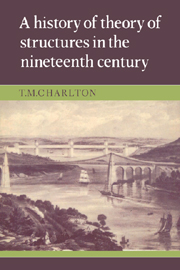
-
Select format
-
- Publisher:
- Cambridge University Press
- Publication date:
- 18 September 2009
- 17 June 1982
- ISBN:
- 9780511524677
- 9780521524827
- Dimensions:
- Weight & Pages:
- Dimensions:
- (228 x 152 mm)
- Weight & Pages:
- 0.32kg, 204 Pages
You may already have access via personal or institutional login
Book description
The spectacular structures of today, such as large suspension bridges, are the result of scientific principles established during the new iron age of the nineteenth century. The book is concerned with a detailed and critical account of the development and application of those principles (including statics and elasticity) by people of remarkable talent in applied mathematics and engineering. They were, of course, mainly motivated by the demands of the railway, construction boom. Among the outstanding examples chosen by the author is Robert Stephenson's use of novel principles for the design and erection of the Britannia tubular iron bridge over the Menai Straits. A History of the Theory of Structures in the Nineteenth Century is a uniquely comprehensive account of a century of the development of the theory; an account which skilfully blends the personalities and the great works and which is enlivened by little-known accounts of friendship and controversy.
Contents
Metrics
Altmetric attention score
Full text views
Full text views help Loading metrics...
Loading metrics...
* Views captured on Cambridge Core between #date#. This data will be updated every 24 hours.
Usage data cannot currently be displayed.
Accessibility standard: Unknown
Why this information is here
This section outlines the accessibility features of this content - including support for screen readers, full keyboard navigation and high-contrast display options. This may not be relevant for you.
Accessibility Information
Accessibility compliance for the PDF of this book is currently unknown and may be updated in the future.


